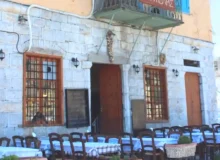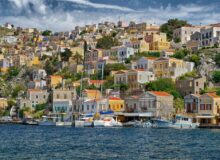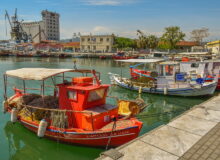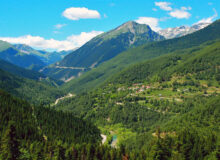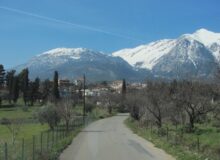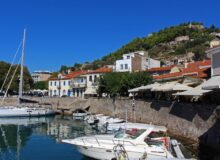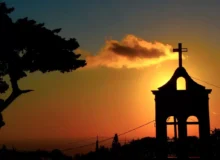The See Greece guide to the island of Astypalea with a brief history and travel information on how to get there by ferry or by air and what to see and do.

In the heart of the Aegean Sea, Astypalea is a hidden gem that blends the charm of the Cyclades with the rugged beauty of the Dodecanese. Often referred to as the “Butterfly of the Aegean” due to its distinctive shape, this island captivates visitors with its whitewashed houses, medieval castles, pristine beaches, and tranquil atmosphere. Whether you’re seeking history, adventure, or relaxation, Astypalea offers an unforgettable Greek island experience.
Where is Astypalea?

Astypalea is part of the Dodecanese island group, located roughly midway between the Cyclades and the larger Dodecanese islands like Kos and Rhodes. It lies about 18 nautical miles northwest of Amorgos (Cyclades) and 50 nautical miles southeast of Naxos. Despite its Dodecanese affiliation, Astypalea’s architecture and vibe are more reminiscent of the Cyclades, making it a unique fusion of both regions.
How Do You Spell Astypalea??
In Greek there’s only one spelling, of course: Αστυπάλαια. When you transliterate that into English it can come out in several ways, such as Astipalaia, Astypalia, and the way we mostly use, Astypalea (though even then it’s different on our map above!) All you need to know is that there is no one correct way.
A Brief History of Astypalea
Astypalea’s history stretches back to ancient times, with evidence of settlements dating to the Bronze Age. The island was known in antiquity as “Pyrra” due to its reddish soil. Over the centuries, it was ruled by various powers:
– Ancient Greece & Rome – The island was part of the Delian League and later under Roman rule.
– Byzantine Era – Christianity spread, and the island became part of the Byzantine Empire.
– Venetian Rule – In the 13th century, the Querini family took control, building the iconic Castle of Astypalea (Kastro).
– Ottoman Period – The Turks ruled from the 16th century until 1912.
– Italian Occupation – After the Ottomans, Italy took over until World War II.
– Modern Greece – Astypalea officially became part of Greece in 1947.
Today, the island retains its medieval charm, with narrow alleys, traditional windmills, and remnants of its storied past.

What to See and Do on Astypalea
1. Explore Chora – The Island’s Capital
Astypalea’s capital, Chora, is one of the most picturesque towns in the Aegean. Its whitewashed houses with blue doors climb up the hill toward the Venetian Castle (Kastro), offering breathtaking views of the sea. Key highlights include:
– The Castle of Astypalea – Built in the 13th century by the Querini family, it houses the Church of Panagia Portaitissa.
– The Windmills – Iconic landmarks offering perfect photo opportunities.
– Archaeological Museum – Showcasing artifacts from the island’s ancient past.
– The Churches – Visit Agios Georgios and Panagia Flevariotissa for stunning interiors.
2. Discover Stunning Beaches
Astypalea boasts some of the most beautiful beaches in the Dodecanese, ranging from organized sandy shores to secluded coves.
– Livadi Beach – A long sandy beach with tamarisk trees, ideal for families.
– Marmari Beach – Shallow waters perfect for swimming and relaxation.
– Vatses Beach – A secluded pebble beach with crystal-clear waters.
– Kaminakia Beach – A remote, unspoiled beach accessible by boat or a rough road.
– Agios Konstantinos – A small, peaceful beach near Chora.
3. Visit the Traditional Villages
Beyond Chora, Astypalea has charming villages worth exploring:
– Livadi – A lush valley with tavernas and a relaxed vibe.
– Maltezana (Analipsi) – A fishing village with excellent seafood restaurants.
– Vathy – A scenic bay with a few tavernas and a tranquil atmosphere.
4. Take a Boat Trip to Koutsomytis & Kounoupes
For adventure seekers, boat excursions to the islets of Koutsomytis and Kounoupes are a must. These uninhabited spots offer fantastic snorkeling and swimming in turquoise waters.
5. Hike to Ancient Sites & Scenic Spots
Astypalea has several hiking trails leading to historical sites and panoramic viewpoints:
– Drakos Cave – A fascinating sea cave with stalactites.
– Ancient Astypalea – Ruins near Pera Gialos with remnants of an ancient acropolis.
– Mount Korakas – The highest point on the island (482m), offering sweeping views.
6. Enjoy Local Cuisine
Astypalea’s culinary scene features fresh seafood, local cheeses, and traditional dishes:
– Lobster Pasta (Astakomakaronada) – A must-try delicacy.
– Xynotyro Cheese – A tangy local cheese.
– Pougia (Sweet Pastries) – Filled with honey and cheese.
Best Time to Visit Astypalea
The best time to visit Astypalea depends on your preferences:
– May to June & September to October – Ideal for pleasant weather, fewer crowds, and lower prices.
– July & August – Peak season with warm temperatures and vibrant nightlife, but busier beaches.
– April & November – Quieter but some businesses may be closed.
How to Get to Astypalea
By Air
Astypalea has a small airport (Astypalaia Island National Airport, JTY) with seasonal flights from Athens (45 minutes) operated by Olympic Air and Sky Express. Flights are more frequent in summer.
By Ferry
Ferries are the most common way to reach Astypalea, with connections from:
– Piraeus (Athens) – Approximately 9-11 hours (overnight options available).
– Cyclades (Amorgos, Naxos, Santorini, Paros) – Seasonal routes.
– Dodecanese (Kos, Kalymnos, Rhodes, Leros) – Via ferry connections.
Key Ferry Operators:
– Blue Star Ferries
– Dodekanisos Seaways (high-speed catamarans)
Getting Around the Island
– Car & Scooter Rentals – Recommended for exploring remote beaches.
– Local Buses – Limited but connect Chora with Livadi and Maltezana.
– Taxis & Boats – Available for tours and transfers.

Final Thoughts
Astypalea is a dream destination for travelers seeking authenticity, history, and natural beauty. Whether you wander through Chora’s labyrinthine streets, swim in secluded coves, or savor fresh seafood by the sea, this island promises an unforgettable escape. With its laid-back charm and stunning landscapes, Astypalea is truly the butterfly of the Aegean—waiting to be discovered.















